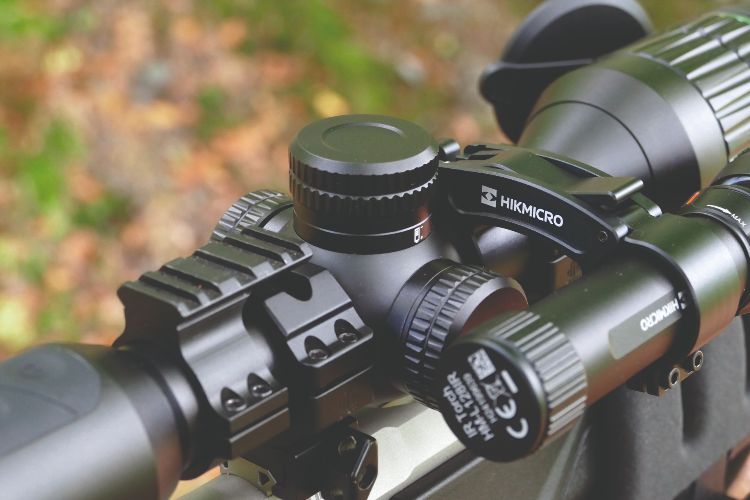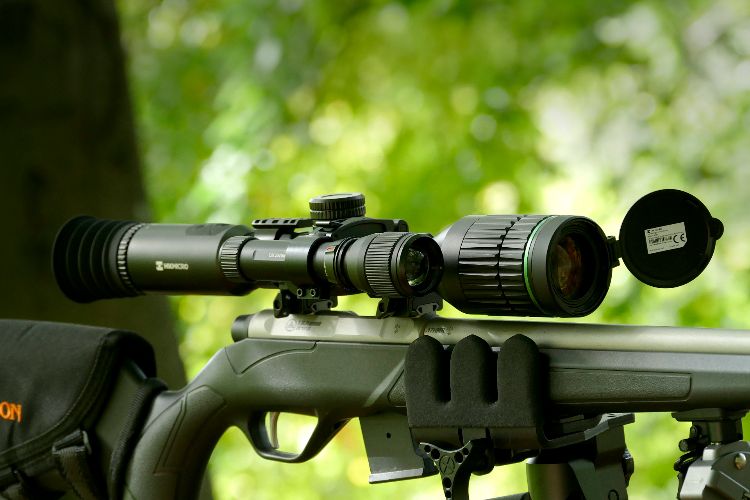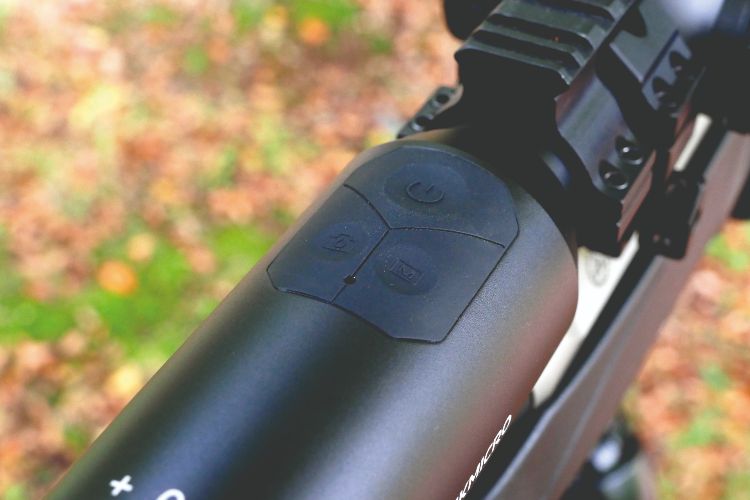HikMicro haven’t really been in the shooting game for very long, but in that time they’ve become a real force in the market, targeting the middle ground and offering good-quality kit at sensible prices. That tradition continues with the Alpex, but with a slight twist. It isn’t merely good, it’s truly exceptional, especially when you factor in the £799 price. As a combined package of performance and price it’s untouchable at the moment.
HikMicro always do a particularly good job of presenting their products. The Alpex ships in a very nice case, but more importantly its contents include everything you need to go shooting except for a pair of 30mm rings. The included torch is a typical example. Most torches that ship with IR scopes are good enough for ratting and rimfire ranges, but they’re often little more than an afterthought and are quickly replaced. The Alpex torch, on the other hand, is superb! It’s got great range for its size, is fully dimmable and adjustable from flood to spot, and it delivers more than enough IR light to go foxing right out of the box.
 I suspect the question for most people is whether the Alpex matches up to what I consider to be the current market leader, the Pulsar C50? Finding the answer is going to form the basis of this review.
I suspect the question for most people is whether the Alpex matches up to what I consider to be the current market leader, the Pulsar C50? Finding the answer is going to form the basis of this review.
In terms of hardware there are no complaints. The scope is based of Hik’s Stellar chassis, which is their 3.5k thermal scope, so there are no concerns in terms of build quality. Battery life is good (up to 12 hours) via an internal battery and replaceable CR123As.
In terms of tech, it does everything you’d expect and more. One-shot zero (with freeze frame), a PIP option, video and still capture, five rifle-zeroing profiles, five ret styles (including an expanding FFP style when zoomed) and seven reticle colours. There are also recoil activated video, a HD 1920x1080 sensor, an OLED display, and obviously it’s all based on a Thermion inspired 30mm tube with wi-fi app connectivity via Hik’s new HikMicro Sight app.
Is there anything I’d change? Yes, there are a couple of things. The array of buttons at the rear could be a little more pronounced, as it’s easy to select the wrong one or accidentally power down the device, especially in the dark and/or when wearing gloves.
The zoom function also takes a bit of getting used to. It ‘smooth zooms’ from base mag to 2x and then again to 4x, smooth zooms back down again to 2x and then jumps straight back to base mag. It looks cool but to be honest I would prefer to be able to jump up and down to the new mag setting instantly. It’s not a big issue and would be easy to change via firmware, but I found it a mild irritation.
 HikMicro Alpex or Pulsar C50?
HikMicro Alpex or Pulsar C50?
Before I answer this question it’s important to put things into perspective. Prior to the launch of the Pulsar C50, the IR scope market had been a dead duck for the best part of two years, with little of note released. All the R&D money was being spent on thermal and I suspected that IR tech had reached its zenith. I was wrong!
The C50 was a revelation, transforming what you could expect from an IR scope and low-light, non-illuminated performance. It was light years better than anything before and remains the gold standard for IR optics in my opinion.
So how close is the Alpex? I’d say very close indeed. I was shocked how well it compared to the C50. Throughout testing I had the C50 and Alpex side-by-side on separate tripods, using the supplied IR and a PBiR-L illuminator with both scopes.
This is HikMicro’s first attempt at IR and it’s running neck and neck with a device that not long ago transformed what you could expect from an IR rig. That alone is a real credit to the Alpex and its designers. If I hadn’t had both scopes side-by-side it would have been very difficult to separate them in terms of performance.
However, there are a few areas in which there is a slight gap between the two. To start with, like most IR scopes the Alpex’s full-colour day image is quite saturated. It’s by no means the worst in the market but it does feel slightly more like a video image. On the other hand, the C50 delivers more accurate colour rendition in the style of a traditional dayscope.
The last-light performance of both these scopes is outstanding. In fact, ‘last light’ isn’t an accurate statement. It must be really pretty dark before you need to reach for the illuminator on either. Again the C50 just (and I mean only just) takes it. The non-illuminated Alpex image has slightly more sparkle and breakup when it’s extremely, dark but it’s a very close-run thing.
I’d also give overall quality of the daytime image to the C50, as I do think its image and glass is slightly superior. However, at max mag the Alpex wins for me as it retains slightly more detail than the C50. In terms of depth of field, again the C50 just takes it, meaning you won’t be reaching for the focus quite so often.
At night and under IR light, again it’s a very, very close call. Once again the C50 just has the edge, probably due to less saturation/contrast within the basic image. During testing I had a pile of old tyres about 70m out. On the C50 you could see the worn treads clearly; with the Alpex you could tweak the brightness and contrast to achieve the same image. But out of the box and with no additional adjustment, the superior balance of the C50 image just tipped the decision in its favour. But to be fair both are stunning IR performers.
While writing this piece I’ve noticed a drop in the price for the Pulsar C50 from £1,099 to £950. Pulsar do not like to discount, and I suspect the appearance of the Alpex at just £799 was the driving force behind this decision, which is a testament to the quality of this new digiscope.
In terms of combined bang for your buck, performance and features, the Alpex is probably the most impressive product I’ve seen this year. Highly recommended.
 Tech specs
Tech specs
Sensor resolution: 1920x1080
Lens size: 50mm, f1.2
Minimum focusing distance: 3m
Protection: IP67 waterproof
Optical mag: 3.5x with up to 4x digital zoom
Display: 1024x768 OLED HD
Video resolution for recording: 1440x1080
Frame rate: 50Hz
App connectivity: Wi-fi hotspot to HikMicro Sight App
Video features: Recoil-activated recording, on-board video recording, picture-in-picture mode
Battery type: Two rechargeable lithium batteries, one internal, one turret external CR123
Dimensions: 442x78x83mm
Weight: 1,062g
Contact
Scott Country International
www.scottcountry.co.uk